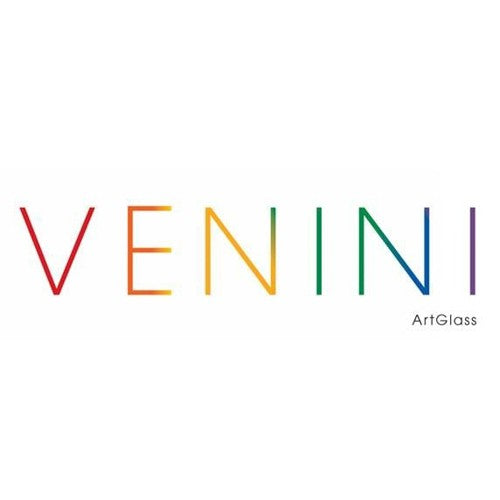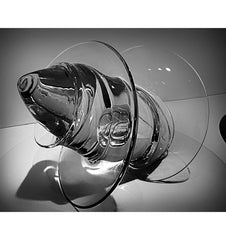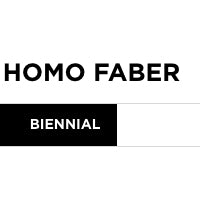
The firm started in 1925 after the split from the Cappellin-Venini & Co. Company: the art director was Napoleone Martinuzzi . At first he followed the lines of Vittorio Zecchin , but he soon departed from these themes and developed an original style of his own, closely linked with his experience as a 20th century's sculpture that would, however, lead him to be increasingly famous in the field of glassmaking.
1920s
In 1928 he made the first pulegoso glass, a material made almost opaque by a huge amount of small air bubbles (said "puleghe") inside the material. The models were thick vases with large ribs such as cactus plants, thistles or imaginary plants as handles.
1930-40s
At the Rome Quadriennale in 1931, Venini exhibited a series of plants of an exceptional size that were greatly appreciated by the head of the fascist regime.
Cooperation between Martinuzzi and Paolo Venini ceased in 1932 when the former decided to set up a furnace of his own, together with the engineer Francesco Zecchin .
In the late 20s Franco Venini , graduated at the Bocconi University (Milan, Italy), and brother to Paolo, joined the factory with a financial share in the firm. He was mainly concerned with the chemical side of factory, and dedicated himself to research in the field of colours. Venini's "cook-book" is his creation, a set of formulas to provide the glass factory with high quality colours, different from all those used in Murano and unsuccessfully imitated by competitors. To this day the range of colours, with the tiniest variations due to the switch from wood to natural gas for heating the glass, is based on these results. Franco Venini died prematurely in 1948, killed by an illness probably caused by the prolonged contact with toxic substances.
For a certain time, the architect Tommaso Buzzi cooperated with the glasswork: so in 1932 we can see the "Laguna" glassware, (rose tinted with gold splashes), again in 1932 the "alga" glassware (green with gold splashes), and other items clearly inspired by the 20th century, such as the "coppa delle mani".
The collaboration with Carlo Scarpa
In 1932 Carlo Scarpa started working for Venini & Co. And over the next few years he would design most of the models produced. Paolo Venini also worked on occasion as a designer and the exact attribution of the individual lines is thus sometimes difficult.
The firm usually presented new productions in "Domus" magazine, frequently at the same time of the opening of important shows or exhibitions, so it's possible to define the chronology of the different items with some degree of accuracy.
In 1934 the furnace produced objects with a mezza filigrana as well as the first sommersiand "diamante" items, so defined because of the effects of the refraction of light off the twin ribs on the surface of the vases. In 1936 he executed vases made of vitreous pastes that go back to Chinese ceramic motifs. In 1940 he proposed sommersi , lattimi , corrosi , battuto alla mola , granulare (black vases with glass pearls included), vases with coloured bands and some of the most famous works by Carlo Scarpa, that is the vases and the bowls with multicoloured murrine (with surfaces smoothened at the wheel), and also pennellati , variegati and a fili , the latter exhibited at the XXII Venice Biennale in 1942.
A splendid retrospective of the collaboration of Carlo scarpa and Venini & C. was presented at the Metropolitan Museum of Art in New York in 2013.
Giò Ponti worked for a brief period with the Venini glass factory: his bottle with an overlaid spiral became famous (this was also made in porcelain with some varations, by the Richard-Ginori firm), as well as the series of multicoloured "a canne" bottles and glasses.
The Swedish sculptress Tyra Lundgren also had remarkable influence over production, as designer of many animal figures, characterized by corroded or iridescent surfaces, as well as of the series of filigrana leaves, exhibited successfully at the 1938 Venice Biennale .
The cooperation with Carlo Scarpa went on up to 1942 and produced some of the best and rarest pieces and they left a permanent mark. To this day Venini uses forms and types of processing initially imposed by the Venetian architect. When the war was over, after a short time of natural uncertainty, the glass factory rose up again thanks to the work of a young and capable designer from Padua (Italy), Fulvio Bianconi . It was a real explosion of creativity: "Commedia dell'arte", "pezzati", "forati", "tiepoleschi", "scozzesi" and especially the famous "fazzoletti" vase, perhaps the best known item of post-war production: a synthesis of free forms and bright and almost violent colours, that could reasonably be chosen as the symbolic item of the past century's Murano glass. In addition to Bianconi, other artists also worked with the Venini firm, on a more or less continuous basis, like Riccardo Licata , Kenneth Scott , Charles Lyn Tissot , Eugene Berman and Massimo Vignelli . We must notice that, while actually employing other designers as well, Paolo Venini was always at their side, acting as supervisor. Each item that left his furnaces was unquestionably and above all a "Venini" model, for the perfection of its technical execution, for the brightness of the colours and for the accuracy of the forms; all exclusive featres of his products, universally recognized and appreciated by critics and the public too. The master glassblowers that, over the years, had made it possible to attain these outstanding standards of quality should not be forgotten: Arturo Biasutto "Boboli" , Oscar Zanetti "Saor" , Ferinando Toso "Fei" , Giacomo Toffolo , Oreste Toso , Barovier "Dedoli" , Mario Tosi "Grasso" and Mario Coletti "Farai" .
From the 1950's
Paolo Venini died in 1959. After his death, the firm's management was taken on by his son-in-law, Ludovico Diaz de Santillana , who carried on with the lines of production already in use, but still expanding external work to well known artists and young outsiders chosen abroad, especially in the United States, in order to give the glasswork's image an increasingly international range. We can list two of the most famous names: Tobia Scarpa (Carlo's son), who, in addition to some series characterized by the use of murrine and of the large battuti, was especially interested in the applications of the glass to architecture; and Thomas Stearns , a young American artist, who designed a series of items giving preference to unusual materials and asymmetrical shapes, despite of initial objection expressed by the maestros: they actually saw something blasphemous, in a way, if related to current traditions.
Other outstanding collaborators were: Toni Zuccheri , from the mainland Venice area, the inventor of interesting brightly coloured vases and of a series of birds, often executed using murrina and combined with a bronze base: this is his "bestiary", partly still present in Venini's catalogue; and Tapio Wirkkala , who enhanced the production range with especially refined series that effectively combined the purity of typical Nordic lines with the colours and the transparencies of the Muranese. A great deal of importance was given to young artists, especially Americans, who joined the works for short periods, and would become the creators of contemporary glass art, such as Richard Marquis , Dale Chihuly and Toots Zinsky . The Venini de Santillana family, in charge of the firm that had also used designs made by Ludovico's sons - Laura and Alessandro - transfered the control of the glasswork in 1986 to the Ferruzzi group through the exchange of shareholdings.
In the early 1990s, with the acquisition of Salviati, Stilnovo, Serenella glass industry (Siv) and Vetrerie Moretti, Venini became an industrial holding company with around 200 employees.
In 1997 control of the Venini brand passed to the Danish group Royal Scandinavia which also took over the famous Swedish brand Orefors-Kosta Boda while launching an international development plan.
In December 2001 the company was taken over by the Italian Luxury Industries group (headed by Giancarlo Chimento). Under his leadership, the brand further internationalises up to 60% of its turnover from the foreign market.
In 2016, the Damiani family that acquired the majority stake in the Italian Luxury Industries group, effectively taking over control of the historic Venini & C. brand.
Currently
Today Venini manufactures over 40 thousand items per year, thanks to the processing of 500 tons of silica sand, 15 ovens turned on 24 hours a day, 800 retailers globally, exclusive single-brand boutiques (Murano, Venice, Milan and a space at the Gate Doha Mall). More than ninety years after its foundation, the brand is still renowned in Italy and abroad for the production of such a valuable artistic glass that some highly selected pieces have been exhibited in the halls of the Met, MoMa and Guggenheim in New York, the Art Institute of Chicago, the Victoria and Albert Museum in London, the Center Pompidou and the Musée des Arts Décoratifs of the French capital, not to mention the National Art Museum of China in Beijing.




